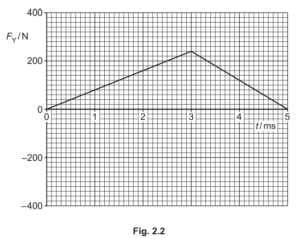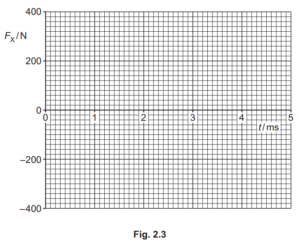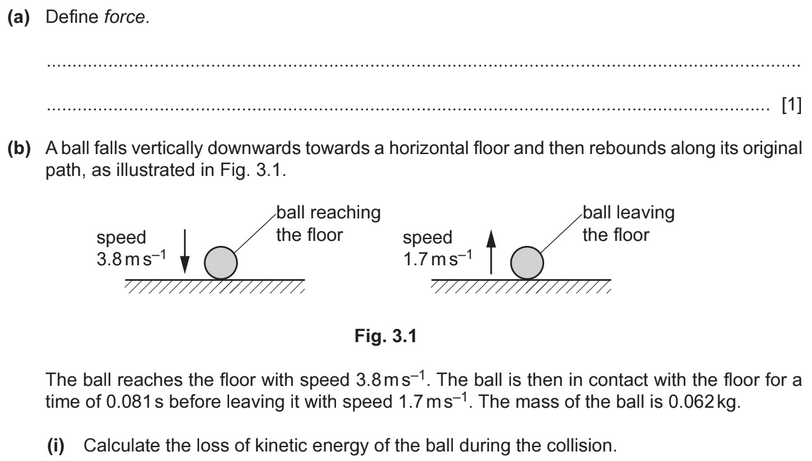Question
(a) Define momentum. [1]
(b) Two balls X and Y, of equal diameter but different masses 0.24kg and 0.12kg respectively,
slide towards each other on a frictionless horizontal surface, as shown in Fig. 2.1.

Both balls have initial speed 2.3 m/s before they collide with each other. Fig. 2.2 shows the
variation with time t of the force FY exerted on ball Y by ball X during the collision.

(i) Calculate the kinetic energy of ball X before the collision.
kinetic energy = ……………………………………………… J [3]
(ii) The area enclosed by the lines and the time axis in Fig. 2.2 represents the change in
momentum of ball Y during the collision.
Determine the magnitude of the change in momentum of ball Y.
change in momentum = …………………………………………… Ns [2]
(iii) Calculate the magnitude of the velocity of ball Y after the collision.
velocity = ………………………………………… ms–1 [2]
(c) On Fig. 2.3, sketch the variation with time t of the force \(F_X\) exerted on ball X by ball Y during
the collision in (b)

[3]
[Total: 11]
Answer/Explanation
Ans
(a) mass × velocity
(b) (i) kinetic energy = ½mv2
= ½ × 0.24 × 2.32
= 0.63 J
(b) (ii) change in momentum = ½ × 240 × 5.0 × 10–3
= 0.60N s
(b) (iii) (change in velocity of Y) = 0.60 / 0.12
( = 5.0 ms–1)
final velocity of Y = 5.0 – 2.3
= 2.7 ms–1
or
(final momentum of Y) = 0.60 – 0.12 × 2.3
( = 0.324 Ns)
final velocity of Y = 0.324 / 0.12
= 2.7 ms–1
(c) sloping straight line from (0, 0) to t = 3.0ms and another straight line continuous with the first from t = 3.0ms to (5.0, 0)
lines showing maximum force of magnitude 240 N
lines wholly in the negative F region of the graph
Question

loss of kinetic energy = ……………………………………………… J [2]
(ii) Determine the magnitude of the change in momentum of the ball during the collision.
change in momentum = …………………………………………… Ns [2]
(iii) Show that the magnitude of the average resultant force acting on the ball during the collision is 4.2N.
(iv) Use the information in (iii) to calculate the magnitude of:
1. the average force of the floor on the ball during the collision
average force = …………………………………………………. N
2. the average force of the ball on the floor during the collision.
average force = …………………………………………………. N
Answer/Explanation
Ans:
\(E=\frac{1}{2}mv^{2} or \frac{1}{2}\times 0.062\times 3.8^{2} or \frac{1}{2}\times 0.062\times 1.7^{2}\)
loss of KE\(=\frac{1}{2}\times 0.062\times (3.8^{2}\times 1.7^{2})\)
=0.36J
(ii)p=mv or \(0.062\times 3.8 or 0.062\times 1.7\)
change in momentum \(=0.062\times (1.7+3.8)\)
=0.34Ns
(iii)average resultant force\(=\frac{0.34}{0.081}=4.2N\)
or
average resultant force\(=0.062\times (1.7+3.8)/0.081=4.2N\)
(iv)average force\(=4.2(0.062\times 9.81)\)
=4.8N
average force=4.8N
